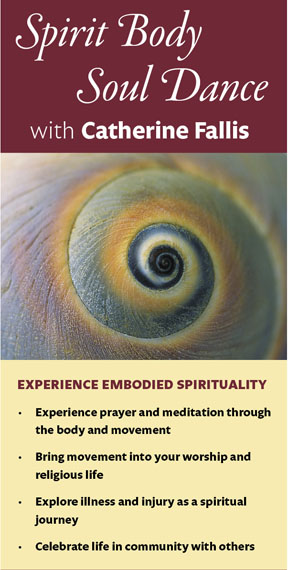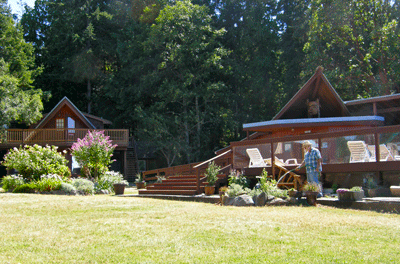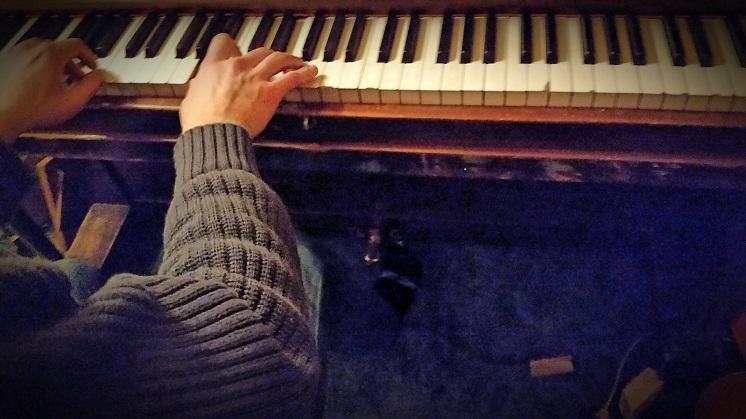Movements of the Spirit
By Catherine Fallis
This article explains some of the background to Catherine’s upcoming program at The Haven, Spirit Body Soul Dance (June 14–16) an embodied exploration of the many varieties of experience that people describe as spiritual.
……………………………………
Stillness is what creates love.
Movement is what creates life.
To be still and still moving . . .
This is everything.
Do Hyun Choe
For a number of years after I began leading two days of movement work in Living Alive Phase II, I would marvel at the profound experiences that sometimes emerged for participants, many of whom had little or no background in dance or movement. These experiences often seemed to take participants momentarily outside the interpersonal issues with which they may have been struggling in the Phase process, to a place of peace and deep connection to both themselves and others. Given my own belief in the power of movement to open our consciousness to a more expansive awareness of ourselves and the world, I was not surprised by this. I was, however, humbled by the ease with which it seemed to occur, and inspired to deepen my understanding of what it means to discover spirit incarnate in the organic movements of our bodies. It was these reflections, and a curiosity about my own experiences of feeling in contact with something greater than myself during movement processes, that lead me to my doctoral work in movement therapy and spirituality at the California Institute of Integral Studies.
The roots of the discipline of Dance/Movement Therapy can be found in the ritual dances and shamanic practices that have been part of culture since ancient times, and can still be found today in many indigenous cultures. Modern western culture is probably the first and only culture that does not have dance as an integral part of healing, worship, and celebration. Merloo (1960) underlines the universality of dance with his comment, “The dance lives in everyone’s body and mind. Somehow, by rhythmic interaction, feelings and emotions are transferred to us. These can lead us into earthbound passions or inspire the most celestial ecstasies” (p. 11). It is understandable then, that when given the opportunity to allow organic movement to emerge from the unconscious, as in the practice of Authentic Movement, the psyche finds a way of using the very matter of our being to connect us with the divine, however we may define it.
In my years of working as a body-oriented therapist, I coined the term “somatic lag,” to describe how the body sometimes lags behind our perceived understanding of a particular issue. Despite thinking we have a good grasp of our own psychological patterns we have not yet been able to change the way we behave. Then, after a session of body work or movement, we have a kind of “ah-ha” experience, as a new layer of insight settles into our whole body/mind, and we are more able to integrate the awareness into our lives. My research into the nature and meaning of experiences described as spiritual that occur during particular movement therapy processes, indicated that this was also true of spiritual knowledge. Ideas with which a person may already have been familiar, emerge again as deep insights because they are experienced as fresh discoveries arising out of their unique constellation of body, mind, and spirit.
As I listened to the experiences of my research participants, I realized that for them and for me, movement has a particular capacity to hold, and for brief moments to resolve, the tension of opposites. Maslow (1964) believed that this resolution of the tension of opposites was a quality of any kind of peak experience. “In peak-experiences, the dichotomies, polarities and conflicts of life tend to be transcended or resolved” (p. 65). One tension that exists in profoundly spiritual movement experiences both for me and for the research participants, is that at the same time as I feel the movement coming from my body, it feels like I am being guided or directed by some outside source, that the movement is happening to me. There is a heightened sense of agency in movement that arises organically in the moment, as opposed to movement practices such as Tai Chi, where the movements are prescribed. There is something critically different when I have no idea what the movement will be when I begin, and I know that it appears from and is expressed uniquely by my own flesh and bone. It is holding this paradox – from me and from outside of me – that makes the experience more striking, and creates what is sometimes called an experience of non duality.
I have meditated both in my mind and in my movement on the tension between movement and stillness. Since my undergraduate studies in literature, I have been fascinated by T.S. Eliot’s lines from the Four Quartets, “at the still point, there the dance is… Except for the point, the still point, There would be no dance, and there is only the dance.” (p. 15-16). Over the years I studied these words, but it was only after I moved with them in a movement and poetry workshop, then danced my anguish and frustration about the stuck places in my life in a vigorous session of Authentic Movement, did what Gendlin (1981) describes as a “felt sense” (p. 10) of what they mean anchor itself in my whole being. After that session I wrote:
Fluidly suspended in the liquidity of existence,
my arms float up to the surface
and then disappear into the sky.
Legs no longer limbs,
but part of the continuous flesh
whose solidity wavers.
Feet on holy ground,
a blessing and a consecration.
I stand in stillness.
Today, young people attending raves and trance dances intuitively know that dance and movement are critical to the full expression of who they are – physically, emotionally and spiritually. Some even connect it to the healing of the planet. In totally different contexts, Evangelical Christians create space for the spirit to move through worshippers’ bodies in tangible ways, and adherents to First Nations and certain Asian spiritual paths include dance in their rituals. It is my belief that we would have fewer problems with anxiety, addiction, and alienation, if we could create more opportunities to move and dance together in community.
……………………………..
Eliot, T.S. (1943). Four Quartets. New York: Harcourt Brace Javanovich
Gendlin, E. (1981). Focusing. New York: Bantam Books.
Maslow, A. (1964). Religions, Values, and Peak Experiences. New York: Penguin Books.
Merloo, J. (1960). The Dance: From Ritual to Rock and Roll. New York: Chilton Company.





